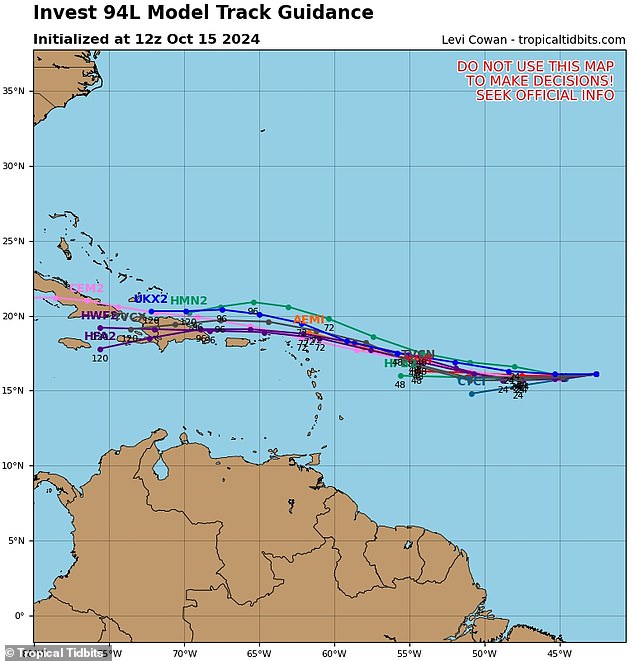Caribbean islands put on hurricane alert as experts say storm Nadine WILL hit this week – raising alarm for Florida
The Caribbean islands have been placed under a storm alert as meteorologists predict Nadine will make an impact this week.
AccuWeather forecasters issued the report on Tuesday, showing that the system’s tropical eye could bring “life-threatening” mudslides to Puerto Rico and cause power outages in the Dominic Republic.
Up to 50 centimeters of precipitation is forecast to fall in northern areas of Hispaniola, along with winds of 140 kilometers per hour.
Experts also said the tropical rain storm’s onshore winds should produce “rough surf, rip currents and coastal flooding along the Atlantic coast, from the Florida Keys and South Florida to the Georgia coast.”
AccuWeather forecasters issued the warning on Tuesday, showing that the system’s tropical eye could bring “life-threatening” mudslides to Puerto Rico and cause power outages in the Dominic Republic.
AccuWeather lead hurricane expert Alex DaSilva said in a statement: “We have been monitoring a tropical wave that moved off the coast of Africa earlier this month.
“This feature has shown some signs of organization in recent days, but could enter a much more favorable area for tropical development this week as it approaches the Leeward Islands in the northeastern Caribbean.”
He further explained that the system could evolve into one tropical storm or “even a hurricane as its core approaches or passes the Leeward Islands late this week.”
Experts are calling Nadine a tropical rain storm because it has the potential to bring significant rain and wind, putting it on radars that it could take a worst turn.
AccuWeather forecast between 4 and 8 inches of rain, with extreme models showing up to 8 inches of rain.
“The heaviest rain is expected over Hispaniola’s rugged terrain, where life-threatening mudslides could occur,” the forecaster said.
The storm will also bring tropical storm force winds that could reach 40 miles per hour, with a maximum of 90 miles per hour.
“Mountainous terrain on these islands can essentially squeeze out precipitation like a sponge,” DaSilva said.
“Flooding rains and mudslides are a major problem in places like Puerto Rico and Hispaniola.”
AccuWeather Senior Meteorologist and Flood Expert Alex Sosnowski said a strong area of high pressure over the eastern U.S. will likely steer the storm away from the southeast coast, blocking rain and wind impacts from reaching Florida.
Impacts include mudslides, power outages and flooding, but the storm could bring winds and high waves to the state.

The latest spaghetti model shows potential paths that will reach the Caribbean islands over the next seven days
“This high-pressure area provides Florida with protection from tropical systems rising in the south, but it also creates hazards along the coast in the Southeast,” Sosnowski explained.
‘This high pressure area over the east coast is getting stronger.
“These persistent onshore winds will push ocean water toward the Atlantic coast.
‘Some areas will experience above-normal tides, coastal flooding at high tide and significant beach erosion. This pressure of wind and water against the east coast of Florida will make it difficult for these swollen rivers to recede.”
Sosnowski said families and businesses near flooded rivers in Florida could face the effects of Hurricane Milton for weeks.
“This is a slow-moving disaster in Florida. The heavy rainfall and winds from Hurricane Milton are long gone,” Sosnowski continued.
“Now we’re dealing with one to two feet of rainfall working its way through the river systems.
‘We’re not out of the woods yet. Some places will experience river flooding issues for weeks.”
